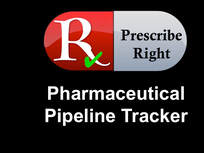|
Update on investigational drugs with recent PDUFA dates:
In other developments: In a Phase III trial, Pfizer’s tafamidis reduced all-cause mortality (30% vs 43%) compared to placebo. Tafamidis also reduced cardiovascular-related hospitalizations, decline in 6-minute walk test and decline in the Kansas City Cardiomyopathy Questionnaire–Overall Summary that measures health status. ADR were similar between tafamadis and placebo in the trial. Approved in the EU, it does not have PDUFA Date but does have Orphan Drug, Breakthrough Therapy, and Fast Track Priority Designations. Esperion announced that in a Phase III trial, in patients with atherosclerosis already receiving a high dose of statin, bempedoic acid and ezetimibe reduced LDL another 35% compared to 3% with placebo, 24% with ezetimibe monotherapy and 20% with bempedoic acid monotherapy. In a posthoc analysis of patients intolerant to statins, LDL was reduced 43% compared to 1% with placebo. In a 2,230 patient, Phase III trial, 13 patients (0.9%) that received bempedoic acid died compared to 2 (0.3%) in the placebo group. Esperion explains that 5 of the deaths were related to lung cancer. Esperion plans to price bempedoic acid < $4,000/ year. No morbidity or mortality results have been announced in bempedoic acid trials. No PDUFA date and no Priority Designations. A small study found that naltrexone reduces the antidepressant effects of intravenous ketamine, suggesting that opioid system activation is required for the antidepressant effect with ketamine. Since esketamine is a derivative of ketamine, this new data will affect how the drug is viewed for its place in therapy. AstraZeneca announced that in the 12-month Phase III trial, in patients with systemic lupus erythematous, anifrolumab did not reduce disease activity as measured by the SLE Responder Index, compared to placebo. AstraZeneca has another Phase III trial, ongoing evaluation of anifrolumab as a treatment for systemic lupus erythematous. Biogen announced that interim data from a Phase Ib trial suggest that after 3 years with a titrated dose and 4 years with a fixed dose, aducanumab (for Alzheimer’s disease) continued to show a reduction in amyloid plaque and a continued benefit on the rate of decline of the Clinical Dementia Rating Sum of Boxes (CDR-SB) and the Mini-Mental State Examination (MMSE). Ultragenyx may file an NDA for triheptanoin in late 2018 or 2019 with possible review in 2019. The drug has an Orphan Drug Priority Designation. Karyopharm announced that in the 122 patient, Phase IIb, STORM trial, treatment with selinexor resulted in a 25% overall response rate in patients with highly resistant multiple myeloma. In a Phase IIb trial, progressive multiple sclerosis patients treated with MediciNova’s ibudilast had 47% less brain atrophy (about 2.5 ml) compared to placebo. In a Phase II trial, treatment with capmatinib plus gefitinib demonstrated an overall response rate of 47% in patients with advanced c-MET-dysregulated non-small cell lung cancer (NSCLC). Among 161 patients in two early trials the most common adverse events with capmatinib were nausea, peripheral edema, decreased appetite, and rash. In a draft report, ICER estimated an annual cost of $24,700 and $46,488 for patisiran to be cost effective and $15,300 and $25,400 for inotersen to be cost effective. You can access up-to-date information on all drugs in the late stages of development with the Prescribe Right Pharmaceutical Pipeline Tracker. Comments are closed.
|
Stay informed, subscribe to the
Prescribe Right Pharmaceutical Pipeline Tracker Latest Tweets from Prescribe Right
Archives
July 2023
|
Services |
Company |
Support |
© COPYRIGHT 2015. ALL RIGHTS RESERVED.
|


 RSS Feed
RSS Feed